What is good about the German variety of potatoes "Zekura": description, characteristics and reviews
Traditional Russian cuisine cannot be imagined without potatoes. This is our second bread, like rice to the Chinese. Often, in the pursuit of a high yield, farmers forget about taste, preferring new super-productive varieties. The German variety Zekura has all the properties of a quality crop - it has a wonderful taste and high yield. The tubers contain an optimal amount of starch (13–18%) and are suitable for any culinary experiment.
The content of the article
Description of the variety and its origin
Zecura is a mid-early variety from German breeders of the Solana company.
The patent for the sale of seed material is owned by:
- Samara-Solana CJSC;
- ZAO Oktyabrskoe;
- CJSC "Breeding farm" Prinevskoye ";
- LLC "Agrofirma KRIMM";
- LLC "Elite Potato";
- FSBSI "All-Russian Research Institute of Potato Farming" A.G. Lorkha ";
- BRANCH FSBI "Rosselkhoztsentr for Irkutsk Region";
- LLC "Biolab";
- FSBSI "Samara Research Institute of Agriculture" them. N.M. Tulaykova ";
- LLC Molyanov Agro Group;
- SPK "Plemzavod" Detskoselsky ".
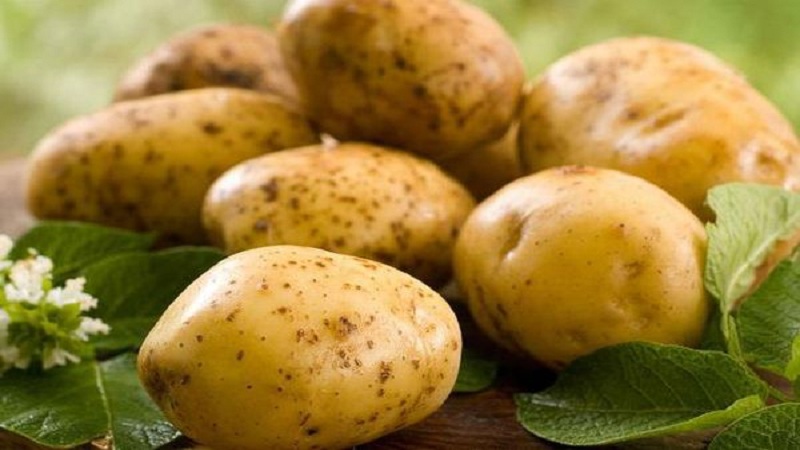
In the photo - Zekura potatoes.
In the table - description and characteristics of the plant.
| Indicators | Characteristic |
| Ripening period | 80–95 days |
| Bush | Medium, intermediate |
| The number of tubers in the bush | 17–20 |
| Weight | 59-150 g |
| The form | Oval, oblong, with small eyes |
| Coloration | Peel and flesh - yellow |
| Leaves | Medium, green, wavy |
| Corolla color | Red-violet |
| Starch content | 13–18% |
| Taste | Excellent (5 on a five-point scale) |
| Cooking class / group | B (medium friable) |
| Yield | Average - 195-323 c / ha, maximum - 365 c / ha |
| Marketability | 79–96% |
| Keeping quality | 98% |
| Appointment | Dining room |
| Sustainability | Cancer, aureus nematode, leaf-rolling virus, late blight of leaves and tubers, glandular spot, viruses A and Y, relative resistance to common scab |
| Transportability | High |
How to grow a variety on the site
Zecura potatoes were bred specifically for cultivation in European countries, therefore, it demonstrates the best results in the regions of the Central Black Earth Region of Russia. During the experiment, it was possible to find out that the variety quickly adapts to different climates and soil types, due to which it is successfully cultivated in areas with cold climates.
Zekura resistant to drought and easily tolerates excessive soil moisture... The plant is characterized by unpretentious care. It responds to moderate watering and feeding by increasing productivity.
Interesting on the site:
Medium early high-yielding variety "Belmondo"
Ideal potato variety for winter purchase: "Jelly"
Description and characteristics of the potato variety "Laperla"
Timing, scheme and landing rules
 Zekura has an enviable resistance to most nightshade diseases, therefore, does not need to dress the tubers before germination. But for preventive purposes, gardeners soak the seeds in a pink solution of potassium permanganate and in Fitosporin, and 24 hours before planting they are treated with Epin or Zircon to stimulate growth.
Zekura has an enviable resistance to most nightshade diseases, therefore, does not need to dress the tubers before germination. But for preventive purposes, gardeners soak the seeds in a pink solution of potassium permanganate and in Fitosporin, and 24 hours before planting they are treated with Epin or Zircon to stimulate growth.
Selected the site is dug up before landing, harrow and fertilize with mullein - 10 liters per 1 m². Planting time depends on climatic conditions. In the southern regions, planting work begins in the last days of April, in the areas of the middle zone - in the first decade of May, in the north - in the middle or at the end of May. The optimum soil temperature is + 10 ... + 12 ° С.
Plant has a powerful rhizome, so the tubers are sealed at a distance of 40-50 cm... Planting depth - 10 cm on sandy and sandy loam soils, and 6-8 cm - on loam and black soil.
Care
The bushes tolerate the dry period, but long-term lack of moisture is destructive for them... The best solution is to organize drip irrigation on the site. This is especially true for the southern regions of the country. In areas with a temperate climate, plantings are watered as needed.
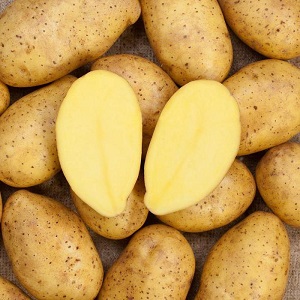 Loosening and weeding is carried out during the period of active growth of green mass... To do this, use glanders, hoes, flat cutters in small areas. The industrial cultivation of potatoes is not complete without cultivators and walk-behind tractors, which greatly facilitate the care of the plantings.
Loosening and weeding is carried out during the period of active growth of green mass... To do this, use glanders, hoes, flat cutters in small areas. The industrial cultivation of potatoes is not complete without cultivators and walk-behind tractors, which greatly facilitate the care of the plantings.
Hilling is a mandatory procedure to protect tubers from the cold, saturate the rhizome with oxygen, facilitate the access of nutrients. The first hilling is carried out after the appearance of sprouts 10-15 cm high, the second - after 2-3 weeks.
The originator did not provide recommendations for fertilization, therefore, farmers are guided by a standard scheme:
| Application period | Top dressing | |
| 1st portion | 14 days after germination | 20 g of dry chicken manure, 25 g of urea per 10 liters of water at room temperature, at the root - 500 ml |
| II portion | Before budding | 15 g of superphosphate and potassium sulfate per 10 l of water, at the root - 500 ml |
| III portion | During flowering | 2 g sodium humate per 10 l, for spraying bushes |
The nuances of growing and possible difficulties
For the successful cultivation of potatoes on the site, it is recommended to observe crop rotation... The best predecessors of the culture: cucumbers, zucchini, cabbage, onions, garlic, beets, peas, beans, lupine, flax, wheat, rye, oats.
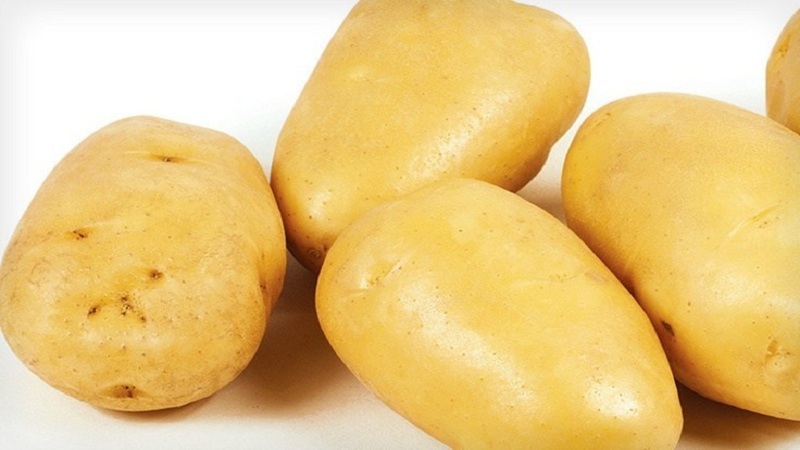
Zekura variety is prone to degeneration, therefore, timely renewal of planting material (once every 7–8 years) guarantees high yield and presentation of tubers.
In addition to traditional cultivation, in practice often use the method of Vladimir Kartelev... The famous scientist and agronomist proposes to cultivate potatoes without tillage. Instead of soil, use grass, which serves as an excellent fertilizer and prevents late blight infection.
The cut grass is left to dry outside, then small stacks are formed and removed to the woodshed. In late autumn, workpieces are laid out on the site. Hay and straw can be used.
In the spring, 30% of the plot is plowed, weeds are removed and even rows with grooves are formed. Manure is placed in the furrows and covered with soil. Next, the tubers and beans are laid, sprinkled with wood ash and soil. No need to tamp. After the appearance of bushes 10 cm high, hilling is carried out.
Interesting fact. Marie Antoinette used potato flowers as a hair ornament. Later, Louis XVI supported her hobby and decorated the boutonniere with them, helping to popularize flowers among French aristocrats.
Diseases and pests
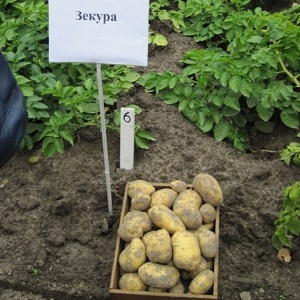 Zecura potatoes have strong immunity and is genetically protected against potato cancer, aureus nematode, leaf-rolling virus, late blight of leaves and tubers, glandular spot, viruses A and Y.
Zecura potatoes have strong immunity and is genetically protected against potato cancer, aureus nematode, leaf-rolling virus, late blight of leaves and tubers, glandular spot, viruses A and Y.
The cultivar has moderate resistance to common scab, but with proper care, the fungus has no chance of developing. Scab develops in calcareous and alkaline soil at air temperatures above + 25 ° C. The fungus enters the tubers through microcracks on the skin. Hard, rough spots of irregular shape appear on the surface.
Reference. Common scab are susceptible to varieties of potatoes with a thin pink skin.
Help reduce the risk of infection:
- watering the bushes during the period of active growth of tubers;
- deep planting in the ground;
- normalization of soil pH;
- acidification of alkaline soil - 40 g of ammonium sulfate per 10 liters of water;
- pre-planting seed treatment;
- crop rotation;
- minimal use of fresh manure;
- storing potatoes in a cool, dry place.
The danger for potato plantings is wireworm and Colorado potato beetle.
The larvae of the click beetle (wireworm) settle in plant debris. Timely harvesting of tops and weeds, deep spring plowing of the site and soil deoxidation will help get rid of the pest.
To reduce acidity, 500 g of slaked soda or lime, 10 liters of water suspension of wood ash are introduced per 1 m².

The introduction of nitrogen-containing fertilizers into the soil will help scare off the larvae:
- 30 g of ammonium sulfate or ammonium chloride per 1 m²;
- 20 g of ammonium nitrate per 1 m².
It is highly effective against wireworm:
- treatment with chemicals "Aktara", "Bazudin", "Prestige", "Diazinon", "Thunder", "Thunderbolt", "Zemlin", biological drug "Nemabakt";
- watering the wells with a 1% solution of potassium permanganate before planting;
- adding onion peel to each hole;
- watering plants with herbal infusion - 200 g of nettle, 100 g of dandelion and coltsfoot, 50 g of celandine in 5 liters of warm water, leave for 24 hours;
- disembarkation near the beds of marigolds.
To scare off the Colorado potato beetle, use:
- dusting bushes with gypsum, lime, corn flour, birch ash;
- spraying with "Corado", "Commander", "Bitobaxicillin";
- spraying with walnut or sunflower infusion - 100 g of raw materials per 10 liters of water;
- planting on the site of garlic, marigolds, nasturtium, calendula, coriander.

Collection, storage and use of the crop
Tubers are formed almost simultaneously... Choice, large fruits are collected from each bush without trifles. Potatoes have an attractive appearance, are aligned in size.
Excavation is carried out in dry, warm weather in early September... The tubers are cleaned of soil and laid out in an even layer in partial shade to dry. Then the crop is put into wooden boxes, nets, burlap and stored in the cellar. Optimum temperature - + 3 ... + 4 ° С, humidity - 70-80%.
On the balcony, tubers are stored in boxes insulated with foam plastic or a special foil screen... The containers are installed on elevations so that they do not come into contact with the cold floor. There are special thermal containers on sale that resemble large hiking backpacks. They are powered by the mains and maintain an optimal storage temperature. In such balcony cellars, the harvest can survive even the coldest winter.
Potatoes stored until the next season, keeping the presentation and taste... The product is suitable for the preparation of mashed potatoes, pancakes, stews, boiled and fried foods.
Read also:
Advantages and disadvantages of the variety
The virtues of culture:
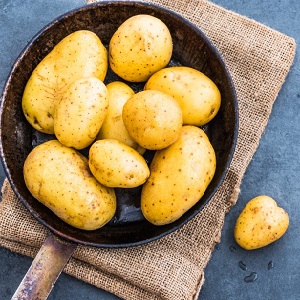 keeping quality;
keeping quality;- evenness of tubers;
- high productivity;
- universal use in cooking;
- strong immunity;
- high adaptive abilities;
- excellent taste.
There are no obvious flaws in the variety... Zecura is deservedly included in the list of the best potato crops.
For which regions is it suitable
Zekura is recommended for cultivation in such regions of Russia:
- Volgo-Vyatsky;
- Central Black Earth;
- North Caucasian;
- Middle Volga;
- West Siberian;
- Far Eastern.
Reviews
Reviews of the Zekura variety are more than positive... The culture is appreciated for its undemanding growing conditions, high productivity and excellent taste.
Valentine, Kirov: “In the summer I move to my dacha and devote all my time to growing vegetables. Every year I allocate a small area for planting potatoes. I consider Zekura one of the best varieties. It is very easy to care for the landings. I water the bushes, only when a prolonged drought sets in, I feed them with humates ".
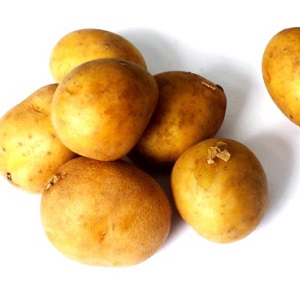 Boris, Nizhny Novgorod: “Zekura is a reliable and undemanding variety. The plant is practically not sick with anything, except that scab appears occasionally. But I immediately throw away the infected tubers, and spores do not develop in the cellar.In the spring, I soak the tubers in potassium permanganate before planting ".
Boris, Nizhny Novgorod: “Zekura is a reliable and undemanding variety. The plant is practically not sick with anything, except that scab appears occasionally. But I immediately throw away the infected tubers, and spores do not develop in the cellar.In the spring, I soak the tubers in potassium permanganate before planting ".
Inga, Borisoglebsk: “This amazing German variety has made us happy for many years, remaining on the list of favorites. Delicious and flavorful yellow potatoes cook quickly, but do not turn into mush. We prepare all sorts of dishes from it, store it in the basement until spring. The variety resists most diseases, and we get rid of Colorado by processing with ash or infusion of walnut leaves ".
Conclusion
Zecura is a high-yielding German variety with a strong immunity and an attractive presentation of tubers. The harvested crop is stored in a cool and dry place until the next season without loss of flavor. Tubers do not sprout or turn green, and are suitable for preparing a variety of dishes.
The culture is undemanding to the composition of the soil, adapts to any weather conditions and tolerates short-term drought.